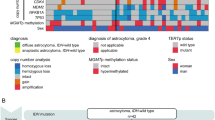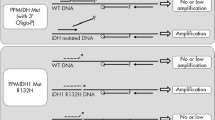Abstract
The World Health Organization Classification of Tumors of the Central Nervous System 5th Edition (WHO CNS5) introduced a newly defined astrocytoma, IDH-mutant grade 4, for adult diffuse glioma classification. One of the diagnostic criteria is the presence of a CDKN2A/B homozygous deletion (HD). Here, we report a robust and cost-effective quantitative polymerase chain reaction (qPCR)-based test for assessing CDKN2A HD. A TaqMan copy number assay was performed using a probe located within CDKN2A. The linear correlation between the Ct values and relative CDKN2A copy number was confirmed using a serial mixture of DNA from normal blood and U87MG cells. The qPCR assay was performed in 109 IDH-mutant astrocytomas, including 14 tumors with CDKN2A HD, verified either by multiplex ligation-dependent probe amplification (MLPA) or CytoScan HD microarray platforms. Receiver operating characteristic curve analysis indicated that a cutoff value of 0.85 yielded optimal sensitivity (100%) and specificity (99.0%) for determining CDKN2A HD. The assay applies to DNA extracted from frozen or formalin-fixed paraffin-embedded tissue samples. Survival was significantly shorter in patients with than in those without CDKN2A HD, assessed by either MLPA/CytoScan or qPCR. Thus, our qPCR method is clinically applicable for astrocytoma grading and prognostication, compatible with the WHO CNS5.




Similar content being viewed by others
Data Availability
The datasets generated during and/or analysed during the current study are available from the corresponding author on reasonable request.
References
Louis DN (2016) WHO classification of tumours of the central nervous system. International Agency for Research on Cancer, Lyon.
Brat DJ, Aldape K, Colman H et al (2020) cIMPACT-NOW update 5: recommended grading criteria and terminologies for IDH-mutant astrocytomas. Acta Neuropathol 139:603–608
Louis DN, Perry A, Wesseling P et al (2021) The 2021 WHO Classification of tumors of the central nervous system: a summary. Neuro Oncol 23:1231–1251
Appay R, Dehais C, Maurage CA et al (2019) CDKN2A homozygous deletion is a strong adverse prognosis factor in diffuse malignant IDH-mutant gliomas. Neuro Oncol 21:1519–1528
Yang RR, Shi ZF, Zhang ZY et al (2020) IDH mutant lower grade (WHO Grades II/III) astrocytomas can be stratified for risk by CDKN2A, CDK4 and PDGFRA copy number alterations. Brain Pathol 30:541–553
Shirahata M, Ono T, Stichel D et al (2018) Novel, improved grading system(s) for IDH-mutant astrocytic gliomas. Acta Neuropathol 136:153–166
Passon N, Pozzo F, Molinis C et al (2009) A simple multiplex real-time PCR methodology for the SMN1 gene copy number quantification. Genet Test Mol Biomarkers 13:37–42
Zhang X, Huang M, Wu X et al (2013) GSTM1 copy number and promoter haplotype as predictors for risk of recurrence and/or second primary tumor in patients with head and neck cancer. Pharmgenomics Pers Med 6:9–17
Satomi K, Ohno M, Matsushita Y et al (2021) Utility of methylthioadenosine phosphorylase immunohistochemical deficiency as a surrogate for CDKN2A homozygous deletion in the assessment of adult-type infiltrating astrocytoma. Mod Pathol 34:688–700
Arita H, Narita Y, Matsushita Y et al (2015) Development of a robust and sensitive pyrosequencing assay for the detection of IDH1/2 mutations in gliomas. Brain Tumor Pathol 32:22–30
Luchman HA, Stechishin OD, Dang NH et al (2012) An in vivo patient-derived model of endogenous IDH1-mutant glioma. Neuro Oncol 14:184–191
Setoodeh R, Schwartz S, Papenhausen P et al (2013) Double-hit mantle cell lymphoma with MYC gene rearrangement or amplification: a report of four cases and review of the literature. Int J Clin Exp Pathol 6:155–167
Idbaih A, Ducray F, Dehais C et al (2013) SNP array analysis reveals novel genomic abnormalities including copy neutral loss of heterozygosity in anaplastic oligodendrogliomas. PLoS ONE. https://doi.org/10.1371/annotation/27807b78-9c79-414a-a47e-fb3eca621be4
Kamb A, Gruis NA, Weaver-Feldhaus J et al (1994) A cell cycle regulator potentially involved in genesis of many tumor types. Science 264:436–440
Suzuki H, Aoki K, Chiba K et al (2015) Mutational landscape and clonal architecture in grade II and III gliomas. Nat Genet 47:458–468
Reis GF, Pekmezci M, Hansen HM et al (2015) CDKN2A loss is associated with shortened overall survival in lower-grade (World Health Organization Grades II-III) astrocytomas. J Neuropathol Exp Neurol 74:442–452
Korshunov A, Casalini B, Chavez L et al (2019) Integrated molecular characterization of IDH-mutant glioblastomas. Neuropathol Appl Neurobiol 45:108–118
Aoki K, Nakamura H, Suzuki H et al (2018) Prognostic relevance of genetic alterations in diffuse lower-grade gliomas. Neuro Oncol 20:66–77
Varn FS, Johnson KC, Martinek J et al (2022) Glioma progression is shaped by genetic evolution and microenvironment interactions. Cell 185:2184-2199.e16
Kocakavuk E, Anderson KJ, Varn FS et al (2021) Radiotherapy is associated with a deletion signature that contributes to poor outcomes in patients with cancer. Nat Genet 53:1088–1096
Barthel FP, Johnson KC, Varn FS et al (2019) Longitudinal molecular trajectories of diffuse glioma in adults. Nature 576:112–120
Schmidt EE, Ichimura K, Reifenberger G, Collins VP (1994) CDKN2 (p16/MTS1) gene deletion or CDK4 amplification occurs in the majority of glioblastomas. Cancer Res 54:6321–6324
Schmidt EE, Ichimura K, Messerle KR et al (1997) Infrequent methylation of CDKN2A(MTS1/p16) and rare mutation of both CDKN2A and CDKN2B(MTS2/p15) in primary astrocytic tumours. Br J Cancer 75:2–8
Acknowledgements
We thank the Laboratory of Morphology and Image Analysis, Biomedical Research Core Facilities, Juntendo University Graduate School of Medicine and Research Institute for Diseases of Old Age, Juntendo University School of Medicine for technical assistance.
Author information
Authors and Affiliations
Contributions
Study design: Y.S., K.I., and A.K.; Data collection: M.S., O.A., S.Y., M.O., M.T., Y.M., Y.N., and A.K.; Data analysis: I.O., Y.M., K.S., and K.I.; Manuscript drafting: Y.S. and K.I.; Supervision: A.K. All authors have read and agreed to the published version of the manuscript.Declarations.
Corresponding author
Ethics declarations
Conflict of interest
The authors declare that they have no conflicts of interest related to this work.
Additional information
Publisher's Note
Springer Nature remains neutral with regard to jurisdictional claims in published maps and institutional affiliations.
Supplementary Information
Below is the link to the electronic supplementary material.
Rights and permissions
Springer Nature or its licensor (e.g. a society or other partner) holds exclusive rights to this article under a publishing agreement with the author(s) or other rightsholder(s); author self-archiving of the accepted manuscript version of this article is solely governed by the terms of such publishing agreement and applicable law.
About this article
Cite this article
Shimizu, Y., Suzuki, M., Akiyama, O. et al. Utility of real-time polymerase chain reaction for the assessment of CDKN2A homozygous deletion in adult-type IDH-mutant astrocytoma. Brain Tumor Pathol 40, 93–100 (2023). https://doi.org/10.1007/s10014-023-00450-z
Received:
Accepted:
Published:
Issue Date:
DOI: https://doi.org/10.1007/s10014-023-00450-z




